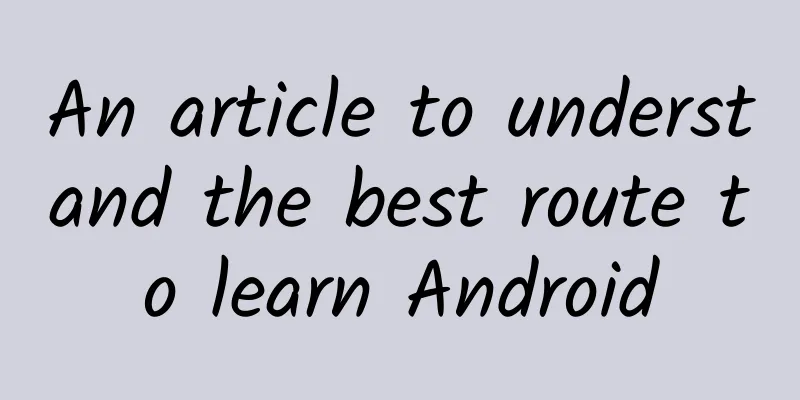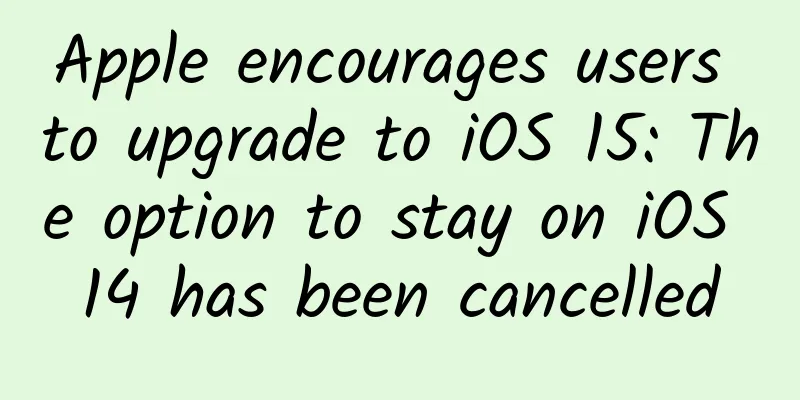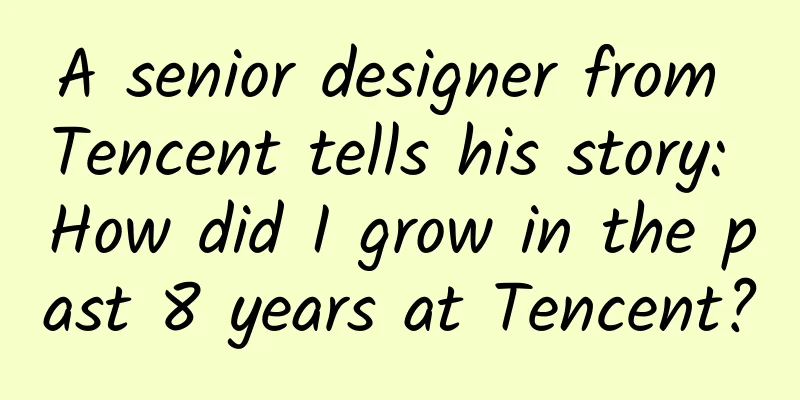An article to understand the best route to learn Android

|
Preface I saw an article saying "In recent years, there have been many junior Android programmers in China, but mid-level and senior Android technical talents are still scarce." This is indeed true. From some interviews I have conducted at Baidu, it is not easy to find a suitable senior Android engineer. Generally, a large number of interviews are required to select a satisfactory one. Why are there not many mid-level and senior Android programmers? This is a question that I cannot answer, but I want to write an article to describe the Android learning route, hoping to help more Android programmers improve themselves. Since I am also a rookie, I will write this article based on my personal experience and my understanding of the Android learning process, which will make this article more real, rather than just talk. My work experience As mentioned before, I was also an Android rookie. In fact, this sentence is applicable to everyone, that is, everyone has come step by step, so as a beginner, there is no need to be depressed because of poor skills. Similarly, experts should not look down on some so-called rookies, because it is unfair. Technology is only comparable to a certain extent when the working years are the same. Maybe the rookie in your eyes is just a novice who has worked for half a year, while you have been working for 5 years. It is conceivable that this is not comparable at all. Maybe others can reach a higher technical level than you in 5 years. I have several technical QQ groups. The friends in the group (481798332) are quite interested in my work experience, so I will introduce it here. I graduated with a master's degree. I have been working for 3 years and 3 months. My position has changed from a junior engineer at Tencent to a senior Android engineer at Baidu. I didn't work on Android at the beginning. I worked in C++ for half a year, then worked on the Web front-end for 3 months, and then transferred to Android within the company until now. In fact, my pure Android work experience is 2.5 years. But I think my Android work experience (Note: work experience is not the same as work experience) is more than 2.5 years. I have invested a lot of my spare time in Android development, and I am used to thinking about problems, summarizing problems and integrating them, so my Android technology has improved greatly in a short period of time. In the process of learning Android, I have also stepped on the pitfalls that beginners have stepped on, and I also deeply know what are the most difficult problems in everyone's learning process. For example, three years ago, I wanted to put a ListView in a SlidingMenu, and found that the two could not always work well together. This must be due to the problem of sliding conflict. I also knew it, but I didn't know how to solve it. I went to the school library and looked through all the Android books, but to no avail. Everyone must know the reason why I couldn't find the answer to the problem in the book, because the introductory book does not talk about sliding conflicts, and the so-called advanced programming books don't talk about it. There is another problem. I used to think that view.post(runnable) can make the run method of runnable execute in the thread, so I did time-consuming operations in the run method. Now think about how green I was at that time, so I was also a rookie. Until one day several years later, I finally figured out the sliding conflict, and then I wrote the idea of solving the problem on the CSDN blog, but it seems that not many people read it, and many people can't understand my intentions. Later, the number of visits to my blog increased, and it slowly attracted the attention of some people. Later, one day I had the opportunity to write a book. I thought about the pitfalls I stepped on when I first learned Android, and the troubles caused by sliding conflicts. In order to better spread my technical experience, to let more people step on fewer pitfalls, and to let more people become senior Android engineers, I resolutely decided to reveal the most important, most difficult, most troublesome and necessary knowledge points in Android development. This is the reason and significance of "Exploring the Art of Android Development". How is the response to the book? Judging from the current readers' evaluation, there is basically no negative review of the content. I have received a lot of affirmation and thanks from readers, which shows that many people can understand my intentions. Having said so much, let's get back to the topic of Android learning routes. This article intends to make a comprehensive analysis of the Android learning process from four stages, namely Android beginner, intermediate, advanced and senior engineers. Please see the analysis below for details. Similarly, this learning route is still only for Android application development, not Rom development and reverse engineering, etc. Here, a virtual character "Xiao Ming" is created, and Xiao Ming is the representative of Android beginners. Junior Engineer Xiao Ming had never been involved in Android development before. He was a fresh graduate with a salary of 13k. Then Xiao Ming joined Baidu as a campus recruit. What should Xiao Ming learn to become a junior engineer? At this time, Xiao Ming had a basic understanding of programming, data structure, C language, and Java syntax. Android only has Java language, but Xiao Ming didn't know how to develop Android. Xiao Ming first needs to buy an introductory book on Android. In order to learn Android faster, Xiao Ming spent his spare time reading the book and typing code according to the examples in the book. As a result, Xiao Ming learned the book in two weeks. After reading the book, Xiao Ming had a general understanding of Android's history, structure, and code standards, and Xiao Ming could already write some simple Activities. At this time, in Xiao Ming's eyes, Android development is very simple and fun. By placing some buttons, text boxes, etc. in XML, you can create some interfaces. Xiao Ming started to work on requirements with his technical mentor. Xiao Ming was naturally able to handle some simple requirements. Suddenly one day, a requirement came in, which required Xiao Ming to add an animation effect to a button in the Activity. Xiao Ming panicked: "I have never been exposed to it before, and it is not mentioned in the book. What should I do?" Xiao Ming calmed down, opened Baidu search, entered "Android animation", opened the first few links, and Xiao Ming suddenly realized it. He implemented the requirements according to the examples on the Internet. Later, the mentor told him: "To learn Android well, you must read the official documents, which are comprehensive and authoritative." Then Xiao Ming was overjoyed and spent a year reading the above guide and training, and he also copied a few small examples. One day, Xiao Ming needed to do an animation-related requirement again. This was not difficult for Xiao Ming. He skillfully opened www.baidu.com and typed "Android animation". Suddenly he was stunned for a moment: "I can't always search Baidu every time I write an animation!" So he opened a blog on CSDN and wrote down all the knowledge points related to animation, so that he would not have to search Baidu when he wrote animation-related codes later. What was the fact? When Xiao Ming wrote animation-related codes later, he did not have to search Baidu again, because by writing an animation blog, he had memorized all the details related to animation, so he did not have to refer to any documents. Later, Xiao Ming also learned to write some trivial things that were inconvenient to put on the blog on Evernote. Whenever he forgot something, he could quickly find it within 10 seconds instead of spending 10 minutes searching again. To summarize, when getting started with Android, you need to have an introductory book and study the contents of the book carefully. At the same time, spend a year reading the training and guide in the official Android documentation. At the same time, write a blog and take notes to summarize. It is recommended to make each of your blogs valuable. After a year of study, I believe everyone can reach the level of an intermediate engineer. Technical requirements: - Basic knowledge points For example, how to use the four major components, how to create a Service, how to layout, simple custom View, animation and other common technologies - Book recommendations "The First Line of Code Android", "Crazy Android" Intermediate Engineer After a year of hard work, Xiao Ming finally became an intermediate Android engineer with a monthly salary of 17k. As an intermediate engineer, he can already do a lot of physical work in the company, but Xiao Ming cannot take on some important tasks alone. At this time, Xiao Ming needs to learn a lot, as shown below: - AIDL: Be familiar with AIDL, understand its working principle, and know the difference between transact and onTransact; - Binder: Understand the working principle of Binder from the Java layer and the use of Parcel objects; - Multi-process: Proficient in the operation mechanism of multi-process, understand Messenger, Socket, etc.; - Event distribution: elastic sliding, sliding conflict, etc.; - Play with View: View drawing principles, various custom Views; - Animation series: Be familiar with the differences between View animation and attribute animation, and understand the working principles of attribute animation; - Understand performance optimization and be familiar with tools such as mat - Understand some common design patterns Learning Methods Reading advanced books, reading Android source code, reading official documents and trying to write relevant technical articles by yourself requires a certain technical depth and self-reflection. During this stage of learning, there are two points that are more troubling for everyone, one is reading source code, and the other is custom View and sliding conflicts. How to read the source code? This is a headache, but the source code must be read. When reading the source code, do not delve into the details of the code, but pay attention to the flow of the code and try to dig out useful conclusions for application layer development. In addition, carefully read the comments of a class or method in the source code. When you don't understand the source code, the comments in the source code can help you better understand the working principle of the source code. Although this process is difficult, there is no other way. How to play with custom views? My suggestion is not to learn custom views by learning custom views. Why? Because there are too many types of custom views, all kinds of gorgeous custom effects, how can you learn to play with them! We need to see the essence through the phenomenon and pay more attention to the knowledge points required for custom views. Here is a summary: - Understand the sliding principle of view - Understand how to achieve elastic sliding - Understand view sliding conflicts - Understand view measure, layout and draw - Then learn some existing custom view examples - Finally, you can customize the view. It will take about another 1-2 years to reach the technical level of a senior engineer. I personally think that this process can be shortened to 0.5-1 year through "Exploring the Art of Android Development" and "Android Heroes". Note that reaching the technical level of a senior engineer does not mean that you can become a senior engineer immediately (it is affected by opportunities and whether you change jobs), but once the skills are reached, becoming a senior engineer is just a simple matter. Technical requirements: - Slightly more in-depth knowledge AIDL, Messenger, Binder, multi-process, animation, sliding conflict, custom View, message queue, etc. - Book recommendations "Exploration of the Art of Android Development", "Android Heroes" Senior Engineer Xiao Ming became the senior engineer he had always dreamed of, with a monthly salary of 20k and a few stocks. At this time, Xiao Ming's Android level was already good, but Xiao Ming's goal was to become a senior engineer. Xiao Ming heard that the monthly salary of a senior engineer could reach 30k+. In order to become a senior Android engineer, there are more things to learn, and some of them are not so specific, as follows: - Continue to deepen your understanding of the content defined in "Slightly In-depth Knowledge Points" - Understand the core mechanism of the system: 1. Understand the SystemServer startup process 2. Understand the message loop model of the main thread 3. Understand how AMS and PMS work 4. Be able to answer the question "How many windows does an application have?" 5. Understand the general workflow of the four major components 6. … - Details of basic knowledge points 1. Activity startup mode and performance of different activities under abnormal circumstances 2. Association between Service's onBind and onReBind 3. The difference between onServiceDisconnected(ComponentName className) and binderDied() 4. Performance details of AsyncTask on different versions 5. Thread pool details and parameter configuration 6. … - Familiar with design patterns and have architectural awareness Learning Methods At this time, there is no specific learning method. It is nothing more than reading books, looking at source code and doing projects. I usually summarize in various ways and try to integrate the knowledge to form a systematic feeling. At the same time, this stage has certain requirements for architecture. Architecture is abstract, but design patterns are concrete, so we must strengthen the study of design patterns. Regarding the study of design patterns, I recently recommended a new book to everyone, "Android Source Code Design Pattern Analysis and Practice", which can not only learn design patterns, but also experience the design ideas in Android source code. I am also reading this book recently. Technical requirements: - Slightly more in-depth knowledge - System core mechanism - Details of basic knowledge points - Design patterns and architecture - Book recommendations "Exploration of the Art of Android Development", "Analysis and Practice of Android Source Code Design Patterns", "Analysis of the Android Kernel" Senior Engineer I am still at this stage and am still groping forward. |
<<: A simple and crude front-end and back-end separation solution
>>: Starting a business? Actually, I just don’t want to work.
Recommend
What does app operation do? How much does App operation and App development cost?
We often hear many companies say they want to mak...
Is the information flow optimization effect so good? Optimization skills of the information flow girl with a monthly salary of 2w+!
A few days ago, the editor was thinking about one...
Mengfei Goods · 2022 Douyin Goods Sharing Short Video Training Camp, the current hot spot for bringing goods to realize the model, from entry to mastery
Mengfei Goods · 2022 Douyin Goods Sharing Short V...
How much does it cost to customize a large turntable mini program in Jinzhou?
There are two types of customization of Jinzhou B...
Do girls have any physiological reactions when kissing? How does it feel when a girl kisses you?
Kissing is a way for boyfriends and girlfriends t...
The basic logic of Internet advertising
No ToC product can survive without Internet adver...
Private domain traffic matrix for ToB operations!
Currently, ToB companies generally acquire custom...
How does a novice sell goods through live streaming? What should you pay attention to when selling goods through live streaming?
How does a novice sell goods through live streami...
Huawei users must know these "life-saving" functions
In recent years, Huawei has been making continuou...
WeChat Mini Program Promotion and Operation, How to Promote and Publicize Mini Program?
WeChat mini-program applications have penetrated ...
Seven-day abdominal exercise Baidu cloud download
Seven-day abdominal exercise resource introductio...
How to conduct an effective activity review?
Reviewing is different from summarizing. Summariz...
2021 Douyin no-source practical full-process store opening and product selection operation course
2021 Douyin no source of goods practical operatio...
50 marketing models that planners must have in 2022
I have the model in hand and the idea. If you don...
7 proven growth strategies for startups!
If you are starting a business , you will definit...









